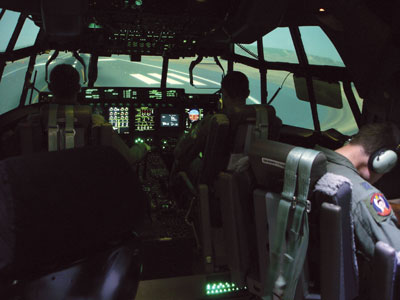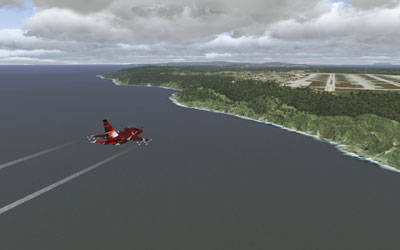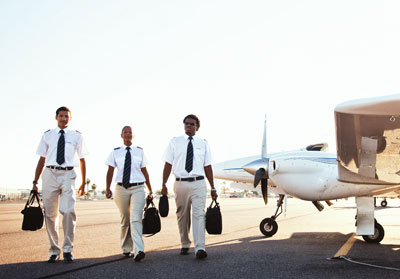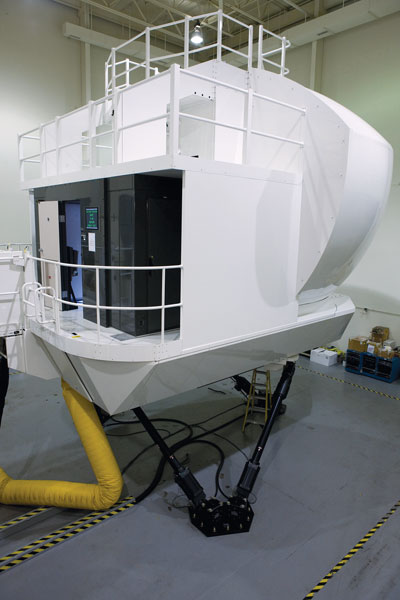
News
Proving to be the real deal
It seems not a week goes by without CAE announcing it has been awarded another contract, be it military, commercial, fixed-wing, rotary, training or maintenance.
November 1, 2012 By Brian Dunn
It seems not a week goes by without CAE announcing it has been awarded another contract, be it military, commercial, fixed-wing, rotary, training or maintenance.
 |
|
| CAE continues to grow its defence portfolio with contracts to deliver eight additional C-130J simulators to various units of the United States Air Force. PHOTO: CAE
|
This year alone, it is developing the first simulators for five new aircraft, among them the Airbus A350 and the new Bombardier CSeries.
On the military side, the Montreal-based company ended fiscal 2012 with more than $897 million in revenue and $950 million in orders, including a record order from the U.S. of more than $400 million in the fourth quarter. On the civil side, revenue reached $841 million and the company booked record orders with an expected value of $1.1 billion.
The first quarter of fiscal 2012 got off to a good start with revenue of $480 million, or 12 per cent higher than in the first quarter last year. The civil side accounted for $251 million of sales, up 20 per cent, compared to $203 for the military, down two per cent. It already announced sales of 10 simulators this year and expects a figure in the mid-30s by fiscal year-end.
“We booked orders during the quarter for a suite of fixed-wing Advanced Jet Trainer aircraft simulators and training devices and we received a contract to perform upgrades on the U.S. Navy’s MH-60S and MH-60R Seahawk helicopter maintenance trainers,” said Marc Parent, CAE’s president and CEO. “We also got an order from the U.S. Air Force to upgrade a C-5 weapons systems trainer. In services, we received a contract to continue providing in-service support for the Canadian Forces CF-18 aircraft, and a contract to provide training support services for the Royal Australian Air Force on C-130H and C-130J aircraft. We received $145.5 million in combined military segment orders this quarter.”
Asia, Australia, Canada, Central and South America and the Mideast are grouped together and account for 36 per cent of CAE’s sales, followed by the U.S. at 34 per cent and Europe at 30 per cent.
The company has come a long was since it was founded on St. Patrick’s Day in 1947 as Canadian Aviation Electronics by Ken Patrick, an ex-Royal Canadian Air Force officer. His goal was to “create something Canadian and take advantage of a war-trained team that was extremely innovative and very technology-intensive.”
 |
|
| CAE’s SIMs train an impressive 100,000 pilots and crew annually on more than 130 different types of aircraft. PHOTO: CAE
|
The company was originally housed in a vacant aircraft hangar at Saint-Hubert Airport, before moving to its current location near Pierre Elliott Trudeau International Airport in Dorval. With an original workforce of 18, CAE started to repair and overhaul ground communications equipment and install Antenna Farms in the Arctic for the RCAF.
In 1952, the company entered the simulator business with a contract from the RCAF to develop a CF 100 flight simulator. Having no prior experience in this highly specialized field, it signed a seven-year licensing agreement with Curtiss-Wright Corporation of the United States to provide technological support. By late 1957, 10 additional units had been delivered, including the company’s first export order to the Belgian Air Force.
Since the pioneer days, it has diversified from its original aviation roots into medical and mining simulation and, although these areas now represent less than five per cent in annual sales, they continue to grow. Along the way, CAE has passed, acquired or sold competitors such as Singer, L-3 Link and Thales to become the largest flight simulator manufacturer in the world. Annual revenue, equally split between civil and military, was more than $1.8 billion in fiscal 2012, up 12 per cent from a year ago, while the company’s order backlog stood at more than $3.7 billion during the same period.
The company has approximately 8,000 employees, including 3,900 in Canada, at more than 100 sites and training locations in more than 30 countries. It has the largest installed base of flight simulators and training devices globally with 1,300. The SIMs train an impressive 100,000 pilots and crew annually on more than 130 different types of aircraft. In addition, CAE is one of the top Canadian companies investing in R&D, accounting for 10 per cent of annual revenues.
 |
|
| CAE has expanded its network of training centres to 42 with the acquisition of Oxford Aviation Academy. PHOTO: CAE
|
In May, CAE expanded its network of training centres to 42 with the acquisition of Oxford Aviation Academy. Through the $309 million purchase, the company has added seven civil aviation training centres in Denmark, Norway, Sweden, the U.K. and Hong Kong, while gaining 40 full-flight and 27 cabin-crew simulators. CAE also gained four ab initio flight schools in the U.S., U.K., Australia and Hong Kong equipped with 88 airplanes. Over the past 50 years, Oxford’s academies have trained more than 26,000 pilots.
The latest is a new training centre in Seoul, Republic of Korea, to train pilots for the Boeing 737-800 aircraft. The CAE Seoul centre will be located near Gimpo International Airport and was scheduled to be ready for training by fall 2012. CAE Seoul will initially feature a Boeing 737-800 full-flight simulator and Integrated Procedures Trainer. Additional training capability will be added as needed to serve carriers in Korea and Japan. This will be CAE’s second civil aviation training location in Korea and 14th deployed or announced in Asia and Australia. CAE offers third-party training capability in Seoul on an A330 FFS in the Asiana Airlines training centre.
In addition, CAE has become the first independent training provider to be qualified as a Civil Aviation Administration of China (CAAC) approved training organization for maintenance training for Dassault Falcons under China’s CCAR-147 regulation. The approval enables CAE to deploy maintenance training courses in China for the 7X, 900EX EASy, 900DX, 900LX, 2000EX EASy, 2000DX and 2000LX. CAE has yet to announce where the training centre will be located (likely Shanghai) or when it will go into operation.
In the defence market, CAE provides innovative solutions to the forces of more than 50 nations in order for troops to be ready for their missions. This year, it delivered the first simulator for the Alenia Aermacchi M-346 advanced lead-in-fighter trainer and for the Boeing P-8 Poseidon maritime patrol aircraft. It is also developing the first simulator for AgustaWestland’s new AW189 helicopter.
 |
|
| This year, CAE delivered the first simulator for the Alenia Aermacchi M-346 advanced lead-in-fighter trainer and for the Boeing P-8 Poseidon maritime patrol aircraft. PHOTO: CAE
|
“Defence forces are looking for the most advanced technologies for effective mission training. Already, we are involved in networking multiple flight simulators, as well as linking virtual simulators to live aircraft in joint exercises,” Marc Parent, president and CEO said at CAE’s annual meeting in August. “More and more, militaries are extending their use of virtual simulation and will increasingly bring together virtual training across air, land and sea platforms and personnel to conduct highly realistic mission rehearsals. This innovation means an aircrew on a simulator in Canada and an aircrew flying a real aircraft in Europe will be able to participate in the same mission rehearsal exercise.”
CAE continues to lead through innovative partnerships and relationships with its customers. A good example is its joint venture with Air Asia, the largest low-cost carrier in Asia. “At the beginning, we sold the airline simulators, and then we operated its training centre. Today, we train all its pilots, maintenance technicians, cabin crew and ground personnel. This is actually a total outsourcing of the airline’s training needs,” Parent said.
In defence, it continues to grow its long-standing relationship with Lockheed Martin on the C-130J Super Hercules with contracts to deliver eight additional C-130J simulators to various units of the United States Air Force.
CAE’s latest foray is into what Marc St-Hilaire calls the Augmented Engineering Environment (AEE) in the development of Bombardier’s CSeries aircraft. Basically, AEE is a comprehensive suite of engineering services and simulation-based technology tools, including an engineering development simulator. It is designed to facilitate the exchange of information in real time between system models by providing a set of tools that can visualize data, map and report information on the exchange flow.
“What it does is take the definition of aircraft, piece by piece as it is defined by the aerospace engineer and builds a simulation model to deliver to the OEM so . . . we can assemble a virtual simulated aircraft much earlier in the development timeline than has been done before,” explained St-Hilaire, CAE’s vice-president of technology and innovation. “It helps validate designs through engineering simulation. We’re not touching the airframe design. We’re into systems modelling supported with a full-flight training simulation.”
While it is a first for Canada, CAE has adapted AEE to Japan’s Mitsubishi for the MRJ and to India’s NAL. The advantage of AEE is that it can detect problems early in the development process, thereby avoiding potential delays of months which could add up to hundreds of millions of dollars in cost overruns, according to St-Hilaire.
In terms of customer support, CAE can monitor simulation failures 24 hours a day and it can usually repair them with a reset button. From SIM development to R&D, to expansion into new markets, CAE continues to show it’s the real deal on the global stage.